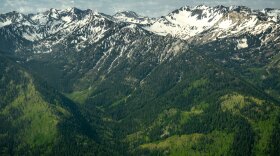-
The Trump administration wants to do away with the Roadless Area Conservation Rule. Established in 2001, it stopped road construction and logging on national forest lands — including four million acres in Utah.
-
The Northern Utah Type 3 Incident Management Team has reported 22 drones flying into temporary flight restricted areas around the Buckley Draw fire near Provo. They say that’s a record — and a dangerous one.
-
The Utah Conservation Corps has roots in the 1930s Civilian Conservation Corps, and it, too, is about giving people an opportunity.
-
At Grand Canyon National Park, a lightning-sparked fire that started July 4 highlighted the challenges of using fire to benefit the landscape. The wind-whipped flames ended up consuming a historic lodge and dozens of other structures.
-
The call from Forest Service Chief Tom Schultz may sound prudent, but many fire policy experts worry it may signal a return to aggressive suppression that has been linked to growing wildfire severity.
-
Farrell Hayes represents something that veteran firefighters say is harder to come by these days: a young person who wants to get involved in firefighting.
-
The proposal would make 18.7 million acres of Utah public lands eligible to be sold, including parcels that overlap with popular trails like Mount Ogden, Grandeur Peak and Mount Timpanogos.
-
Nationwide, tens of thousands of Indigenous households use firewood to help heat their homes. That's why the Washoe Tribe of Nevada and California is making sure their elders have the chopped wood they need.
-
Workers who maintained trails, removed combustible debris from forests and secured funding for wildfire mitigation projects say the loss of these federal positions could impact public safety.
-
Massive federal layoffs are hitting communities across the West, including rural, recreation hotspots like McCall, Idaho. Here's how that town is responding.
-
In the Western U.S., extreme wildfires are damaging tribal lands. Climate change has only made the situation more dire. That’s why the Washoe Tribe of Nevada and California is working to reintroduce intentional, cultural fire.
-
Beyond getting a multi-million dollar project on track, backers of Utah’s Uinta Basin Railway also wanted to shrink the scope of federal environmental reviews.
Play Live Radio
Next Up:
0:00
0:00
Available On Air Stations












